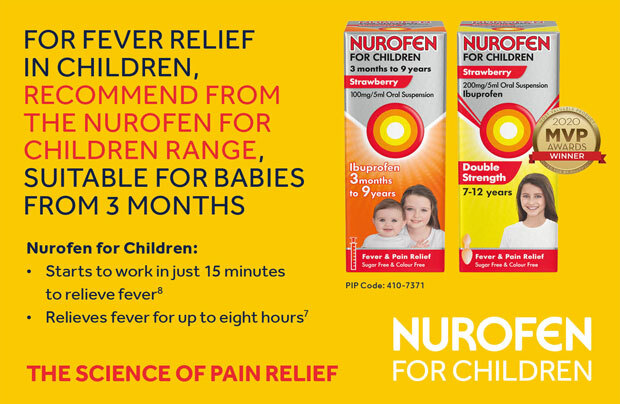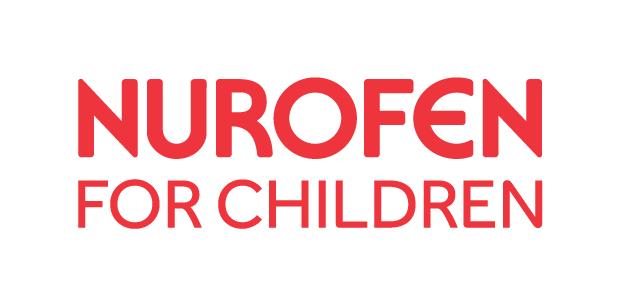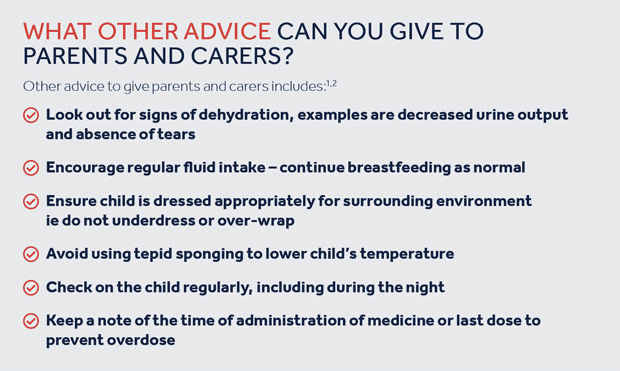What advice can you give parents for fever relief in children
Download the What advice can you give parents for fever relief in children? poster here.
Identifying fever in children
A high temperature is common in young children and usually self-limiting, resolving after 3-4 days.(1) Normal temperature is approximately 36.4°C, but can vary from child to child. An infant or child is considered as having a fever if they have a temperature of 38°C or above.(2)
Using a thermometer
A digital thermometer can be used to measure temperature. The National Institute for health and Care Excellence (Nice) recommends that temperature is measured under the armpit for children aged 0-5 years.(4) Nice advises that it is important to listen to parents who are concerned that their child is feverish or distressed – parental perception of fever alone is an appropriate diagnosis.(4)
Causes of fever
Common causes of fever in infants and children include childhood infections and illnesses such as tonsillitis, chickenpox, the common cold, ear infections and teething. Fever may also occur following vaccinations.(3)
When to refer fever symptoms
When assessing children with fever, the presence of other symptoms and signs can be used to predict the risk of serious illness with the help of a ‘traffic light’ system. Children with fever accompanied by ‘red’ symptoms are considered at high risk of severe illness and require immediate emergency referral (call 999).
‘Red’ symptoms include:(1,4)
- pale, blue or mottled skin, lips or tongue
- weak high-pitched cry
- stiff neck
- dislike of light
- rash that does not fade with ‘glass test’
- drowsy and hard to wake
- unresponsive or confused
- bulging fontanelle
- unusually cold hands and feet.
REQUIRES IMMEDIATE EMERGENCY REFERRAL – CALL 999
‘Amber’ symptoms include:(1,4)
- under three months old and has a temperature of 38°C or higher
- 3-6 months old and has a temperature of 39°C or higher
- has other symptoms of illness eg rash
- fever that has lasted for five days or more
- does not want to eat, or is not their usual self and the parent is worried
- is dehydrated, eg dry nappies, reduced feeding and there are no tears when crying.
REFER IMMEDIATELY TO THEIR GP OR CALL 111
‘Green’ symptoms include:(1,4)
- normal colour of skin, lips and tongue
- responds normally to cues
- content or smiling
- stays awake or wakes quickly
- moist mucous membranes
- normal or no cry.
CAN BE MANAGED AT HOME
Management of fever
Nice recommends that paracetamol or ibuprofen are given first line for the treatment of fever if the child is uncomfortable or distressed. Paracetamol and ibuprofen should not be given together due to increased risk of overdose and renal toxicity.(2)
Consider switching to ibuprofen if paracetamol is not effective or vice versa. The treatments can also be alternated if treatment with paracetamol or ibuprofen alone is not effective. Treatment with paracetamol or ibuprofen should only be continued as long as the child appears distressed.(2)
Aspirin is not recommended for use in children less than 16 years due to risk of Reyes syndrome.(1)
Cautions and contraindications
Paracetamol is licensed for children aged two months and is normally given every 4-6 hours. Ibuprofen is licensed for children aged three months, and is normally given every 6-8 hours. For both paracetamol and ibuprofen it is important not to exceed the dose recommendations or dose frequency.(2) Doses should be based on both age and weight and parents or carers should be advised to consult the patient information leaflet for recommended dosing.
Paracetamol or ibuprofen are available as an oral suspension, and parents or carers should be advised to use a calibrated spoon or oral syringe to administer doses.(2)
Studies have shown that the safety and tolerability of paracetamol and ibuprofen are similar.(4,7) According to Nice guidance, there is no difference in the rate of adverse events and no evidence of harm with the short-term use of paracetamol or ibuprofen at the correct dose.(4)
During the COVID-19 pandemic, parents or carers may be unsure what to do if their child is unwell. To prevent serious illness, pharmacy teams should advise that parents or carers do not delay treatment and seek medical assistance if their child is unwell.(1)
References
- NHS (2020) High temperature (fever) in children.
- National Institute of health and Care Excellence (2018) Clinical Knowledge Summaries: Feverish children - management.
- NHS Inform (2020) Fever in children.
- National Institute of health and Care Excellence (2019). NICE guideline [NG143]: Fever in under 5s: assessment and initial management.
- Tan E, Braithwaite I, McKinlay CJD, Dalziel SR. Comparison of acetaminophen (paracetamol) with ibuprofen for treatment of fever or pain in children younger than 2 Years: A systematic review and meta-analysis. JAMA Netw Open. 2020;3(10):e2022398. doi:10.1001/jamanetworkopen.2020.22398.
- Pelen F, et al. (1998)Treatment of fever: Monotherapy with ibuprofen. Ibuprofen pediatric suspension containing 100mg/5ml, multicentre acceptability study conducted in hospital. Ann Pediatr; 45: 719–28.
- Kelley MT, et al. (1992)Pharmacokinetics and pharmacodynamics of ibuprofen isomers and acetaminophen in febrile children. Clin Pharmacol Ther; 52: 181– 89.8.

NUROFEN FOR CHILDREN 3 MONTHS TO 9 YEARS STRAWBERRY. Oral suspension: Ibuprofen 100mg/5ml (2.0%w/v). Indications: For the fast and effective reduction of fever, including post immunisation pyrexia and the fast and effective relief of the symptoms of colds and influenza and mild to moderate pain, such as a sore throat, teething pain, toothache, headache, minor aches and sprains. Legal category: GSL. Licence Holder: Reckitt Benckiser Healthcare (UK) Limited HU8 7DS. Price: £3.99 for 100ml. Information about this product, including adverse reactions, precautions, contra-indications, and method of use can be found at: https://www.medicines.org.uk/emc/product/8137/smpc.
NUROFEN FOR CHILDREN 200MG/5ML ORANGE/STRAWBERRY. Oral suspension: 200mg/5ml ibuprofen. Indications: Children aged 7-12 years: Rheumatic or muscular pain, headache, dental pain, feverishness, symptoms of cold and influenza. Legal category: P. Marketing Authorisation Holder: RB Healthcare (UK) Ltd., HU8 7DS. Price: £3.99 for 100ml. Information about this product, including adverse reactions, precautions, contra-indications, and method of use can be found at: https://www.medicines.org.uk/emc/product/10458/smpc; https://www.medicines.org.uk/emc/product/10459/smpc.





